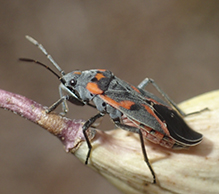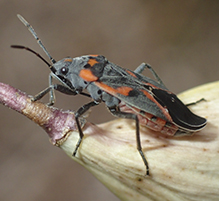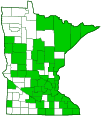small milkweed bug
(Lygaeus kalmii)
Conservation • Description • Habitat • Ecology • Distribution • Taxonomy
Conservation Status |
|
|||||||
| IUCN Red List | not listed |
|||||||
| NatureServe | NNR - Unranked |
|||||||
| Minnesota | not listed |
|||||||
Description |
||
Small milkweed bug is a colorful, medium-sized seed bug. It occurs throughout the continental United States, southern Canada, and Mexico. It is common in Minnesota. It is found in fields, meadows, gardens, and anywhere its host plants are found. It is often found on milkweed pods, and this is the source of its common name. However, a study (Wheeler, 1983) has shown that while milkweed may be a preferred host when available, it can breed successfully on many other plants in the Aster (Asteraceae) family and other plant families. Nymphs and adults feed on milkweed seeds and on nectar from a wide variety of flowers. When these are not available, they feed on other insects. Adults are ⅜″ to ½″ (10 to 12 mm) in length. The body is robust, elongated oblong, and black with red markings. It is colorfully marked, but the colors are muted by a peppering of appressed white scales. The head is short and black with an orange to red spot on the top (vertex). The spot is oblong, not Y-shaped, and is confined to the middle of the vertex. The beak-like part of the head containing the mouth parts (rostrum) has four segments. It is short and slender, and it projects downward and forward when sucking plant juices. It is tucked into a groove on the underside of the thorax when not in use. The antennae are much longer than the head but much shorter than the body. They have four segments including the short basal segment (scape). They are not widened at the tip (clubbed). The exoskeletal plate covering the thorax (pronotum) is wider at the rear than at the front. The front third is mostly black. The rear two-thirds is mostly red with two broad black spots at the rear margin and two small spots at the front. The small spots are free of white scales. The plate between the wing bases (scutellum), is large, triangular and entirely black. There are two pairs of wings, and they are held flat over the body when at rest. The front wings (hemelytra) are longer than the hind wings and only slightly longer than the body. They have a thickened part at the base and a thin, membranous part at the tip, with a clear dividing line between the two. The thickened part is comprised of a narrow area (clavus) behind the scutellum when the wings are closed, and a broad marginal area (corium). The clavus is entirely black. On each clavus, there is a small black spot adjacent to the tip of the scutellum that is free of white scales. The corium is black with a broad, red, X-shaped mark that does not quite meet in the middle. On each corium, there is a small black spot near the midpoint that is free of white scales. The combined black areas on the pronotum, scutellum, clavi, and coria give the appearance of single, large, heart-shaped spot in the middle and a large triangular spot on each side. The membranous portion of the hemelytron is black and has 4 or 5 black veins. On the western subspecies Lygaeus kalmii kalmii, there is a large white spot in the middle divided by a single black vein; a white spot at the base divided by two black veins; a short white spur on each side; and a narrow but distinct and regular white band on the margin. On the eastern subspecies Lygaeus kalmii angustomarginatus, there is no spot or two small spots in the middle and there is no band or a very narrow and irregular band on the margin. The legs are black. The last part of the leg (tarsus), corresponding to the foot, has 3 segments. The last tarsal segment has a pair of claws at the tip and a pad at the base of each claw. |
||
Size |
||
Total length: ⅜″ to ½″ (10 to 12 mm) |
||
Similar Species |
||
Habitat |
||
Fields, meadows, and gardens |
||
Ecology |
||
Season |
||
One generation per year: July through September |
||
Behavior |
||
|
||
Life Cycle |
||
Adults overwinter. Eggs are laid in the spring. |
||
Nymph Food |
||
Milkweed seeds, flower nectar |
||
Adult Food |
||
Milkweed seeds, flower nectar |
||
Distribution |
||||
|
Sources |
|||
| 10/11/2023 | ||||
Occurrence |
||||
Common |
||||
Taxonomy |
|||
Order |
Hemiptera (True bugs, Hoppers, Aphids, and Allies) | ||
Suborder |
Heteroptera (True Bugs) | ||
Infraorder |
Pentatomomorpha | ||
Superfamily |
Lygaeoidea (seed bugs and allies) | ||
Family |
Lygaeidae (seed bugs) | ||
Subfamily |
Lygaeinae | ||
Genus |
Lygaeus | ||
Subordinate Taxa |
|||
eastern small milkweed bug (Lygaeus kalmii angustomarginatus) western small milkweed bug (Lygaeus kalmii kalmii) |
|||
Synonyms |
|||
|
|||
Common Names |
|||
small milkweed bug |
|||
Glossary
Clavus
On Hemiptera: The hard part of the forewing that is adjacent to the scutellum when the wings are closed. Plural: clavi.
Corium
The thickened basal portion of the front wing that lies between the clavus and the membrane of insects in the family Hemiptera. Plural: coria.
Hemelytron
The forewing of true bugs (order Hemiptera), thickened at the base and membranous at the tip. Plural: hemelytra.
Pronotum
The exoskeletal plate on the upper side of the first segment of the thorax of an insect.
Rostrum
The stiff, beak-like projection of the carapace or prolongation of the head of an insect, crustacean, or cetacean.
Scape
In plants: An erect, leafless stalk growing from the rootstock and supporting a flower or a flower cluster. In insects: The basal segment of the antenna.
Scutellum
The exoskeletal plate covering the rearward (posterior) part of the middle segment of the thorax in some insects. In Coleoptera, Hemiptera, and Homoptera, the dorsal, often triangular plate behind the pronotum and between the bases of the front wings. In Diptera, the exoskeletal plate between the abdomen and the thorax.
Tarsus
On insects, the last two to five subdivisions of the leg, attached to the tibia; the foot. On spiders, the last segment of the leg. Plural: tarsi.
Vertex
The upper surface of an insect’s head.
Visitor Photos |
|||||
Share your photo of this insect. |
|||||
| This button not working for you? Simply email us at info@MinnesotaSeasons.com. Attach one or more photos and, if you like, a caption. |
|||||
Alfredo Colon |
|||||
 |
|||||
Babette Kis |
|||||
 |
 |
||||
 |
 |
||||
MinnesotaSeasons.com Photos |
|||||
|
|||||

Visitor Videos |
|||
Share your video of this insect. |
|||
| This button not working for you? Simply email us at info@MinnesotaSeasons.com. Attach a video, a YouTube link, or a cloud storage link. |
|||
Other Videos |
|||
| Small Milkweed Bug (Lygaeidae: Lygaeus kalmii) Close-up Carl Barrentine |
|||
About
Oct 17, 2011 Photographed at Grand Forks, North Dakota (16 October 2011). |
|||
| Small Milkweed Bug Feeding on Hairy Aster margy stewart |
|||
About
Oct 19, 2021 This Small Milkweed Bug (Lygaeus kalmii) is feeding on Hairy Aster (Symphyotrichum pilosum). Richard Root (1986) documented that L. kalmii can feed on plants other than milkweeds--as this video shows it doing right here. Geary Co., Kansas, October 18, 2021. |
|||


Created: 10/11/2023
Last Updated:




